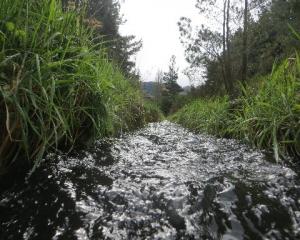The successful launch of Nasa's super pressure balloon from Wanaka Airport yesterday is seen as important for Otago, but there is a lot at stake too for the University of California Berkeley, and the chairman of its physics department, Steve Boggs.
Otago Daily Times Wanaka bureau chief Mark Price put questions to Prof Boggs last week about the Compton spectrometer and imager (Cosi) telescope sent into the stratosphere on board the balloon.
When and how did this project arise?
As experimental scientists, we are always trying to push our frontiers of discovery to new limits. Over a decade ago, we started a discussion in the high energy astrophysics community on how we could improve our telescopes for studying gamma rays from space.
These gamma rays contain unique information on the formation of elements, the centre of exploding stars, and the environment around black holes. The ideas for Cosi arose from those discussions.
We have been developing the critical telescope technologies for Cosi for over 10 years. In parallel, Nasa has been developing their technologies for increasing balloon flights to over 100 days. These two developments are an excellent match!
What questions does it seek to answer?
Cosi is primarily designed to understand where and how new elements are formed in our galaxy. We know from cosmology that mostly hydrogen and helium were formed in the big bang.
Other elements such as carbon, oxygen and iron evolved later in the universe, primarily in stars, and have been reprocessed throughout galaxies by supernova explosions. These processes are still active in our galaxy today, and Cosi is designed to study those active regions of our galaxy.
What previous attempts have been made to get the Compton spectrometer and imager into the stratosphere?
Cosi flew on a two-day flight from Antarctica in December 2014. That flight was cut short due to a leak in the balloon. Fortunately, we were able to recover the payload in excellent condition, and could start preparing for this launch opportunity from Wanaka.
New Zealand has a much better view of the centre of our galaxy, which is important for our science. So we are very excited about this flight.
Why is the information this device can detect not detected by other equipment already in space, or on land?
Cosi sees gamma rays, a high-energy form of light that is invisible to our eyes. Gamma rays from space are blocked by the Earth's atmosphere, so to study them we have to get above 99% of the air.
Balloons get us high enough into space to see the gamma rays. There are other instruments in space designed to study gamma rays, but Cosi is a technologically advanced instrument, which is sensitive to signals much too faint for previous telescopes to detect.
How big a team of scientists are involved in the project?
There are roughly a half-dozen scientists from the US, Taiwan, and France that work on Cosi, as well as a comparable number of graduate students. This is a small project by some standards, but an excellent introduction for the students on how to work in a scientific collaboration.
How valuable will it be for you to have 100 days of data available to you?
Between Cosi and predecessor instruments, we have been working towards this flight for nearly 20 years of my career, developing the needed telescope technologies at Berkeley while Nasa developed the 100-day balloon. We have been anticipating this flight for a long, long time.
Why are you not watching the launch from Wanaka?
I wish I could. Besides being [head] of this project, I am also chair of the physics department here at Berkeley. I had a wonderful few weeks in Wanaka working with my group and Nasa on integration and testing, but other duties back in Berkeley prevent me from staying indefinitely for the launch.
Fortunately, Cosi has an excellent, experienced team in Wanaka.












